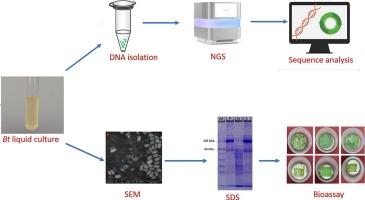Genomic and toxicity analysis of Lepidopteran toxic novel Bacillus thuringiensis strain T407
IF 4
1区 农林科学
Q2 BIOCHEMISTRY & MOLECULAR BIOLOGY
引用次数: 0
Abstract
Bacillus thuringiensis is a gram-positive and spore-forming bacterium recognized for its pathogenicity against a broad spectrum of insect and nematode pests, and it has been extensively employed as a biopesticide. In this study, we examined the morphological, molecular, and genetic features of a native Bt isolate T407, which demonstrated significant toxicity against lepidopteran pests. Scanning Electron Microscopy confirmed the presence of bipyramidal and cuboidal-shaped crystals in T407. SDS-PAGE examination of spore-crystal mixtures revealed two significant protein bands at ∼135 and ∼ 65 kDa, representing Cry1 and Cry2 proteins. The presence of cry and vip gene combinations in T407 was confirmed by PCR analysis. Probit analysis estimates the LC50 values of 0.771, 1.379, 2.038, and 14.997 μg/mL against Plutella xylostella, Helicoverpa armigera, Spodoptera litura, and Spodoptera frugiperda, respectively. The draft genome assembly of the Bt isolate T407 consists of 228 scaffolds, encompassing a total of 6,148,454 bp, with an N50 value of 93,189 bp. A total of 13 plasmids were identified in this genome through BLAST search similarity analysis. Similarly, 6631 protein-coding genes were identified in this genome with 53 tRNA, 4 rRNA, and 5 ncRNA genes. Similarly, a total of 11 insecticidal toxin proteins such as Cry1Ac5, Cry1Aa18, Cry1Ac5, Cry1Aa6, Cry1Ia42, Cry2Aa9, Cry2Ab41, Vip3Aa86, Mpp46Ab1, Vpb4Ca1, and Spp1Aa1 were identified in this Bt genome. In addition to insecticidal toxin genes few other toxin proteins like Zwa5A, Zwa5B, Zwa6, ChitinaseC, InhA1, InhA2, Enhancin, and Bmp1 also identified in this Bt genome.

鳞翅目有毒新型苏云金芽孢杆菌T407的基因组学和毒性分析
苏云金芽孢杆菌是一种革兰氏阳性和孢子形成的细菌,因其对多种昆虫和线虫害虫的致病性而被公认,并被广泛用作生物农药。在这项研究中,我们检测了一种对鳞翅目害虫具有显著毒性的本土Bt分离物T407的形态、分子和遗传特征。扫描电镜证实在T407中存在双锥体和立方晶体。对孢子晶体混合物进行SDS-PAGE检测,发现在~ 135和~ 65 kDa处有两条显著的蛋白带,分别代表Cry1和Cry2蛋白。PCR分析证实T407中存在cry和vip基因组合。Probit分析结果显示,对小菜蛾、棉铃虫、斜纹夜蛾和狐尾夜蛾的LC50分别为0.771、1.379、2.038和14.997 μg/mL。Bt分离物T407基因组组装草图由228个scaffold组成,共包含6148,454 bp, N50值为93,189 bp。通过BLAST搜索相似度分析,在该基因组中共鉴定出13个质粒。同样,在该基因组中鉴定出6631个蛋白质编码基因,其中包含53个tRNA, 4个rRNA和5个ncRNA基因。同样,在该Bt基因组中共鉴定出Cry1Ac5、Cry1Aa18、Cry1Ac5、Cry1Aa6、Cry1Ia42、Cry2Aa9、Cry2Ab41、Vip3Aa86、Mpp46Ab1、Vpb4Ca1和Spp1Aa1等11种杀虫毒素蛋白。除杀虫毒素基因外,在该Bt基因组中还发现了少量其他毒素蛋白,如Zwa5A、Zwa5B、Zwa6、几丁质酶ec、InhA1、InhA2、Enhancin和Bmp1。
本文章由计算机程序翻译,如有差异,请以英文原文为准。
求助全文
约1分钟内获得全文
求助全文
来源期刊
CiteScore
7.00
自引率
8.50%
发文量
238
审稿时长
4.2 months
期刊介绍:
Pesticide Biochemistry and Physiology publishes original scientific articles pertaining to the mode of action of plant protection agents such as insecticides, fungicides, herbicides, and similar compounds, including nonlethal pest control agents, biosynthesis of pheromones, hormones, and plant resistance agents. Manuscripts may include a biochemical, physiological, or molecular study for an understanding of comparative toxicology or selective toxicity of both target and nontarget organisms. Particular interest will be given to studies on the molecular biology of pest control, toxicology, and pesticide resistance.
Research Areas Emphasized Include the Biochemistry and Physiology of:
• Comparative toxicity
• Mode of action
• Pathophysiology
• Plant growth regulators
• Resistance
• Other effects of pesticides on both parasites and hosts.

 求助内容:
求助内容: 应助结果提醒方式:
应助结果提醒方式:


